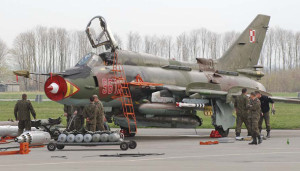
Poland is looking to replace its aging strike force, currently flying Russian built Sukhoi Su-22M with armed unmanned aerial vehicles. According to Waldemar Skrzypczak Poland’s Deputy Minister of Defense for military procurement, a future procurement of some 30 armed drone equipping three squadrons is being considered.
The arguments raised in favor for such decision are that the unmanned drones would be more affordable, particularly considering the logistical burden of maintaining the aging Russian fighters and lack of spares for such platforms. Drones could also operate on longer missions and the training of operators and support personnel will be cheaper, the Polish MOD argues.
Moreover, the deployment of unmanned aircraft, in support of NATO operations overseas or in support of other peacekeeping operations, would become more affordable and require smaller footprint and logistics, compared to similar missions performed by manned aircraft. However, the unmanned platform would require fielding large numbers of advanced, precision guided munitions which will also require adequate field support, technical training for the maintainers and operators.

By the year 2018 most of the Polish Air Force Su-22s will exceed their designed lifespan and require major investment just to keep flying(1). Given an operational capability of the new drones by that time, and eying the versatile operability of the current Su-22s, the options are narrowed to 3-4 platforms – General Atomics MQ-9 Reaper, IAI/Malat Heron TP and Elbit Systems Hermes 900. The Turkish TAI Anka could also be considered, although its payload is limited, compared to the other alternatives.

The Polish acquisition could also be streamlined with other NATO procurement plans – France, Germany, Italy and the UK are currently considering the fielding of armed drones, and are evaluating both the MQ-9 and Heron TP for this role. Both are operated in ‘armed scout’ missions , carrying multiple weapons in different configurations. (although Israel never confirmed its UAVs are operating in such roles, foreign sources have widely reported on Israeli drones carrying and firing missiles.) Theoretically, Warsaw could ask for the MQ-9C Avenger but it is unlikely that Washington would clear the stealthy drone for export before it is inducted into US Air Force service in considerable numbers.
The Su-22 has been in service since 1984. Of the total 110 fighters delivered from Russia only 45 are still operational – 38 Su-22M-4K and seven Su-22UM-3k two seaters. Three squadrons currently operating the Fitters are 8th Tactical Squadron at Miroslawiec and the 40th and 7th Tactical Squadrons at Swidwin.

















